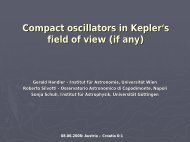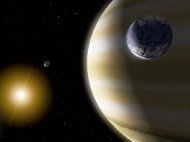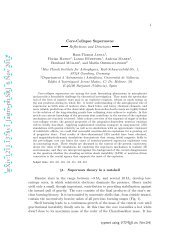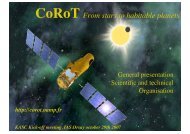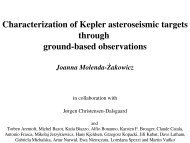PDF file.
PDF file.
PDF file.
- No tags were found...
You also want an ePaper? Increase the reach of your titles
YUMPU automatically turns print PDFs into web optimized ePapers that Google loves.
Stellar Evolution2012, Q2Ugeseddel 9 (week 46)The lectures 12 and 16 November will be given by Günter Houdek who willdiscuss white dwarfs (Kippenhahn & Weigert, Chapter 35; in addition Sections1 – 5 of Althaus et al. (2010) are recommended – see below).On 19 November Günter briefly discusses neutron stars and black holes(Kippenhahn & Weigert, Chapters 36 and 37), and on 23 November I shallconsider aspects of stellar rotation (Kippenhahn & Weigert, Chapters 41 –43).The exercise class on 20 November will consider the exam problem below.Recommended reading on white dwarfs:• Althaus, L. G., Córsico, A. H., Isern, J. & García-Berro, E., 2010.[Evolutionary and pulsational properties of white dwarf stars]. Astron.Astrophys. Rev., 18, 471 – 566.See in particular Sections 1 – 5.This is available athttp://adsabs.harvard.edu/abs/2010A%26ARv..18..471Aor from the website of the coursehttp://owww.phys.au.dk/∼jcd/stel-struc/.9 November 2012 Jørgen Christensen-Dalsgaard1
A4 ASTROPHYSICS I SUMMER 1999EXERCISE 2We consider the collapse of the central part of a star which leads to asupernova explosion. Assume that the collapse comprises 1M ⊙ where M ⊙ =1.989 × 10 33 g is the solar mass, and also that all matter in this part of thestar is converted into neutrons.a) Argue that the conversion of core matter into neutrons results in a neutrinoproduction and give a substantiated estimate of the total numberN ν of neutrinos produced through this process.Detailed models show that also other processes during the explosion contributeto the neutrino production. Thus, the total number of producedneutrinos during the supernova explosion is N ν,tot = 1.2 × 10 58 .b) The neutrinos produced have a mean energy of 10 MeV. Argue that thetotal energy emitted in neutrinos constitutes the dominant part of theenergy which is released by the gravitational collapse. It is assumedthat the core collapses to a radius of 10 km.Consider now the supernova SN1987A in the Large Magellanic Cloud.The distance from the supernova to the Earth was 50 kpc.c) Assume that the neutrino emission took place over a period of 10 s andthat the neutrinos are massless. Determine the average neutrino flux,corresponding to N ν,tot , on Earth.d) The neutrinos were detected with the Japanese Kamiokande detectorthrough scattering of neutrinos on electrons in water. The detector contained2000 tons of water, and the cross section for a reaction between aneutrino and an electron is 4 ×10 −43 cm 2 . Determine the total numberof reactions in the detector. (This number was actually observed!)e) If the neutrinos have a finite mass they move at velocities less thanthe speed of light. This causes a delay ∆t in their arrival relative tothe time of arrival corresponding to the speed of light. Show that forneutrinos from SN1987A( ) 10 MeV 2(mν c 2 ) 2∆t ≃ 2.5 s,E ν 10 eV2
where E ν is the energy of the neutrino, m ν its mass and c the speedof light; note that the relativistic connection between the energy E,velocity v and mass m of a particle isE =mc 2√1 − (v/c) 2 ,and that m ν c 2 can be assumed to be much smaller than E ν .f) The emitted neutrinos have an energy distribution which is assumedto be between 5 MeV and 15 MeV. Argue that if the neutrinos have afinite mass this energy range contributes to the spread in their times ofarrival, and also that it is thus, in principle, possible to constrain theneutrino masses from the observations.3





